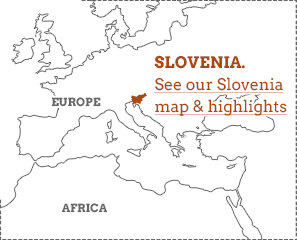Slovenian folklore taps evocatively into the natural wonders of this European jewel. Tales flaunt two dozen expressions just to describe mountain passes in the Julian Alps, the spectacular pinnacles named after early admirer Julius Caesar. The Milky Way is celestial straw spilled by a mythical peasant. Paradise is a flower meadow surrounded by high rocky ridges on the epic Mount Triglav. Seventeenth-century yarns weave magic around secluded lakes in the Kocevje bear forests. But the wonder is how close reality seems to the imagined.
![]()
Slovenia is an exquisite miniature, swooping from its own distinctive Alps to its own distinctive Adriatic.
![]()
Vacations to Slovenia revel in this richly storied diversity: Italianate coastal resorts, lush forests, emerald-green lakes, rushing rivers and snow-capped peaks, all in a landscape sprinkled with fairytale castles and ancient towns. Beneath ground, Europe's largest cave systems give up spectacular archaeological finds. And any Slovenia travel guide should also mention the excellent wine.


